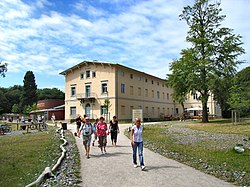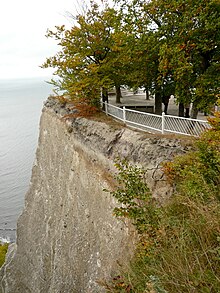National Park Center Koenigsstuhl
| National Park Center Koenigsstuhl | |||
|---|---|---|---|
|
National Park Center Koenigsstuhl |
|||
| place | Sassnitz | ||
| opening | 2004 | ||
| Visitors | 256,000 (2014) | ||
| surface | 28,000 square meters (outside area) | ||
| Website | www.koenigsstuhl.com | ||
|
|||
Coordinates: 54 ° 34 ′ 24 ″ N , 13 ° 39 ′ 36 ″ E
The Königsstuhl National Park Center is the visitor center of the Jasmund National Park on the island of Rügen . It opened in 2004. Its task is to convey information about the national park and to make the uniqueness and beauty of nature tangible for the visitors without significantly damaging the ecology of the national park.
The center offers an interactive exhibition, a multivision cinema and other offers and events in the outdoor area. It is named after the nearby Königsstuhl chalk cliff .
The operator of the center is the National Park Center Königsstuhl Sassnitz gGmbH , whose shareholders are the environmental foundation WWF Germany and the city of Sassnitz .
From the opening in March 2004 to July 2015, over 3 million visitors saw the exhibition.
History and creation of the center
Due to the fascination of the imposing chalk cliffs , there was a need for some amenities at this striking location as early as the 19th century. In 1835, under the direction of Karl Friedrich Schinkel, a wooden inn was built in the Swiss style. After this building burned down several times and was rebuilt, it was decided in 1893 to build a stone hotel. This preserved building has been converted for the exhibition of the National Park Center. Around 1900 it served as an inn and post office. During the Second World War around 1943 it was used as a hospital. It was later occupied by the Red Army . The GDR border troops ( Coastal Border Brigade ) later used these buildings as barracks. Further bunkers and a watchtower were built on the site.
In 1990 the Council of Ministers of the GDR decided to declare this area as a national park . The site lay fallow until 1999 and the buildings fell into disrepair. In 2000 the watchtower and the barracks (except for one) were demolished. Since no further inn for tourists was to be built, the WWF Germany , the state of Mecklenburg-Western Pomerania and the city of Sassnitz founded the Stubnitzhaus Sassnitz gGmbH . A project was started to set up a nature information center. In March 2004, today's Königsstuhl National Park Center was opened.
Goal setting
The Vorpommern National Park Office is responsible for the Jasmund National Park. The employees of the National Park Office act to protect the natural region. They take care of visitor facilities (paths, stairs, etc.) and their traffic safety, as well as environmental education projects.
In contrast, the Königsstuhl National Park Center is intended to make the uniqueness and beauty of nature tangible for visitors and to convey interesting facts about the National Park.
Here a compromise is made with the national park idea. Because nature should be able to develop according to its own laws without human influence, interventions and influences should be minimized as far as possible. With the help of the National Park Center, however, visitors can be able to actively experience nature and enjoy quiet relaxation without harming nature.
The center pursues a uniform concept of environmental protection. Environmental protection should not only be part of the attitude of all employees, but also include all areas of the center, such as the building materials used, the operation of the restaurant and the paper used in the office or for print media.
Offers for visitors
Königsstuhl viewing platform
The Königsstuhl , one of the most impressive rocks on Rügen's chalk coast, is located within the grounds of the National Park Center . There is a viewing platform here that can be reached via a few steps. A listed megalithic grave lies under this platform.
Adventure exhibition
Under the motto of a journey through time - beginning in prehistoric times - the 2,000 m² exhibition shows exhibits such as aquariums and an iceberg glacier. The exhibition is directed using an interactive headphone system. There are three time travel options for adults. There is a separate trip for children: Mimi, the Mouse and Krax, the Raven accompany the little ones with funny stories and child-friendly explanations through the adventure exhibition. You visit z. B. the badger in its burrow and track down mice underground.
Multivision cinema
The moderator Dirk Steffens explains the phenomenon of the old beech forests on four screens . The film tries to convey the UNESCO world heritage to the guests in a powerful way. "The hike of the old beech forests" in the multivision cinema takes 15 minutes; the snail-shaped cinema hall seats around 70 spectators.
Outdoor area
On the outdoor area of 28,000 square meters there are further attractions for children and adults, such as climbing trees, a playhouse, giant swing, the open-air stage with the National Park Theater (performances in July and August), an exhibition on the painting " Chalk Cliffs on Rügen " by Caspar David Friedrich and the UNESCO World Heritage Window.
hikes
Hiking and cycling trails allow you to visit the national park at your own risk. The National Park Center also offers guided hikes and short tours. In addition to the standard hikes, there are thematic hikes that are also based on the seasons.
particularities
Handicap friendly
The National Park Center is handicapped-friendly. Elevators can also be used by people with disabilities and wheelchairs to access all the exhibition rooms. The floor coverings are non-slip. All offers in the outdoor area are wheelchair accessible, with the exception of the Königsstuhl. Directly under the steps to the viewing platform is a megalithic grave from the Bronze Age, so that structural changes are not possible at this point due to the monument protection.
The shuttle bus from the Hagen car park is a low-floor bus and is therefore suitable for wheelchair users. For blind visitors there is the leaflet "Jasmund National Park, Chalk Cliffs by the Sea" in Braille .
dogs
Dogs are allowed in the national park and on the premises of the center if they are kept on a leash. The center building can also be entered with dogs, but the adventure exhibition and the multi-vision cinema are forbidden for dogs, as these rooms were designed to be close to nature. Handicapped assistance dogs are excluded from this rule.
Zero emissions concept
The Königsstuhl National Park Center was designed as a zero-emissions building.
The house is powered by a photovoltaic system . Since the center is in one of the sunniest places in Germany, the system can generate up to 18 kW. In order to use the geothermal energy to generate energy for heating, air conditioning and hot water, a geothermal system was installed on the outdoor area of the National Park Center. Sustainable use of drinking water is guaranteed through new technologies. The drainage concept is determined by a strict separation of the waste water produced according to the degree of pollution. Wastewater is diverted by means of a free slope, fed to a grease separator and fed to the sewage treatment plant for primary treatment. The water cleaned in this way corresponds in its limit values to the EU bathing water directive. The purified water is used exclusively for a second use as flushing water for toilets.
Arrival / paths in the national park
You can drive up to about three kilometers to the Königsstuhl by car as far as the Hagen car park. From there, the bus continues. Alternatively, the Königsstuhl can be reached on foot in around 45 minutes on a well-developed hiking trail. In order to reduce the volume of traffic in the national park, it is recommended to change to buses outside the national park's borders. The VVR buses go directly to the National Park Center and also offer combination tickets.
The most important public road in the national park leads from Sassnitz via Hagen and Nipmerow to Lohme and cuts the national park in a north-south direction. This street has a branch at the tree house Hagen to Stubbenkammer and thus to the national park center. However, this junction is closed to general vehicle traffic between 8:00 a.m. and 8:00 p.m. Passage is then only permitted for cyclists, carriages, buses, vehicles for the disabled, supply and disposal vehicles and vehicles from the National Park administration.
There is a general parking and stopping ban inside the national park and outside the marked areas. Additional parking spaces are located in the Stadthafen parking garage in Sassnitz and at the entrance to the national park next to Stubbenkammerstraße.
In the national park there is a general route requirement. Visitors mainly hike in the stump chamber, the forest hall and on the high bank. There are well-marked hiking trails with a total length of 43 kilometers. The guiding principle of the national park applies to the development of nature on foot. This means that the largest and most cohesive rest areas possible should be created and maintained. To get to the beach, there are three descents from the high bank path. The wooden stairs are on the Hankenufer between Lohme and the Königsstuhl, on the Kieler Ufer and on the Hengst. Two more descents outside the national park are on the national park border to Sassnitz am Wedding, another in Lohme. Only these descents are permitted.
literature
- Carsten Hertwig, Ralf Röchert: On our birthday on March 18, 2004: The Königsstuhl National Park Center on Rügen opens its doors . In: National Park . No. 123 , 2004, pp. 42-44 .
Web links
- Website of the National Park Center Königsstuhl
- Website of the Jasmund National Park
- Portal of the state government of Mecklenburg-Western Pomerania - The Jasmund National Park in the portal of the state government of Mecklenburg-Western Pomerania
Individual evidence


